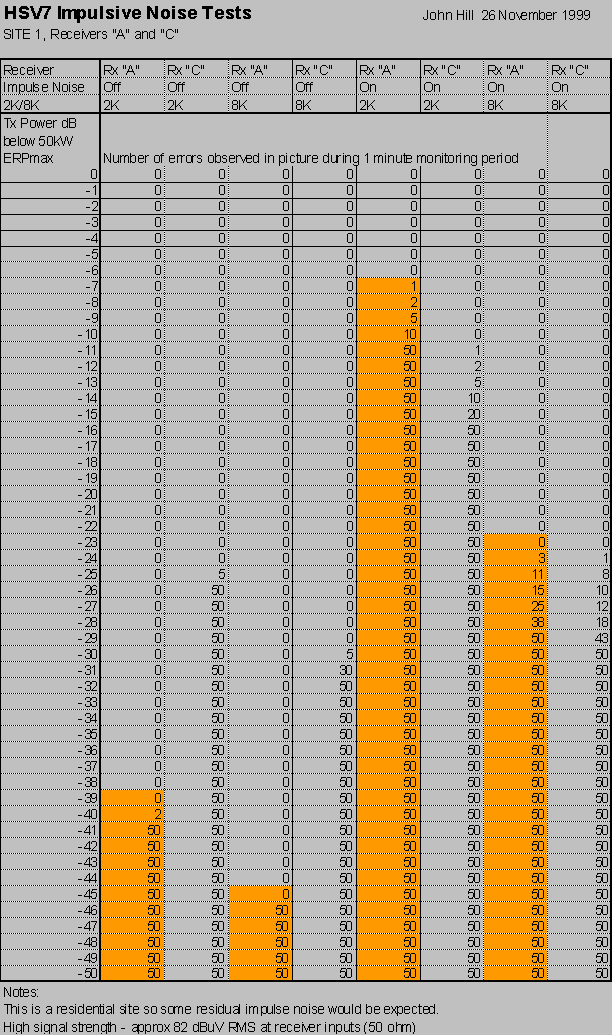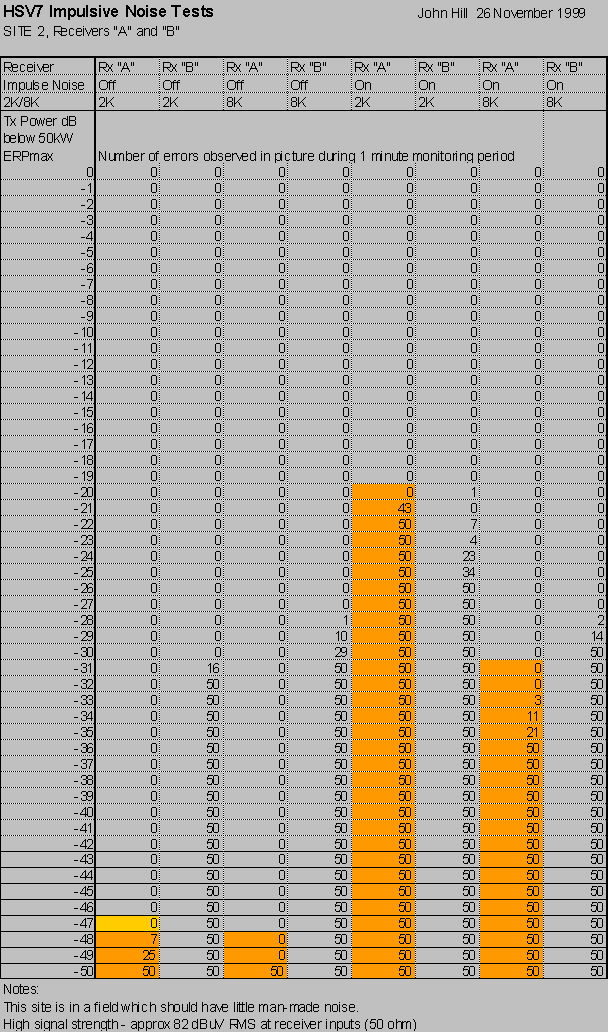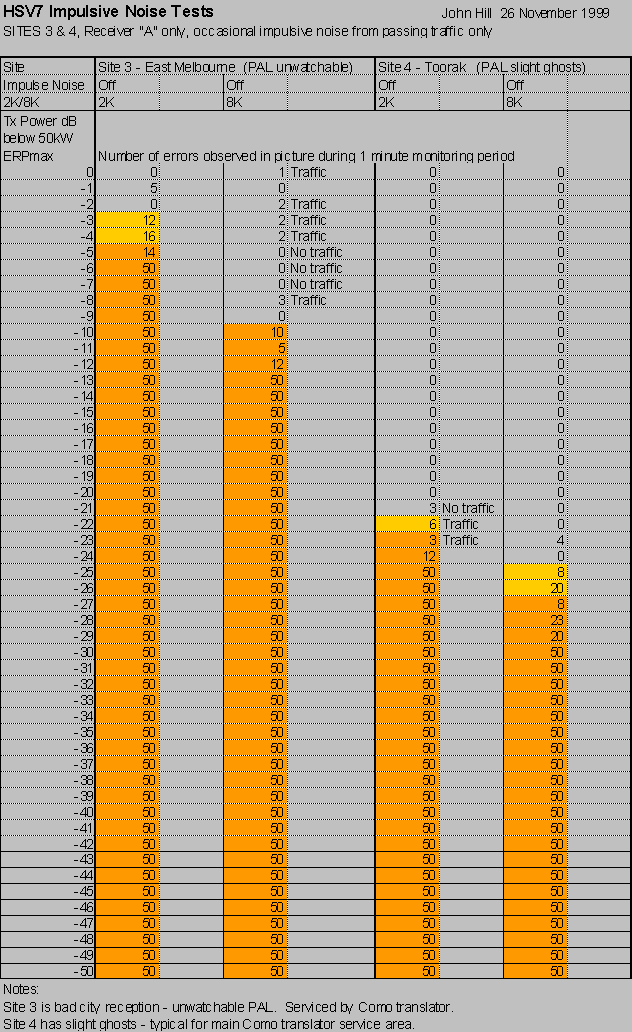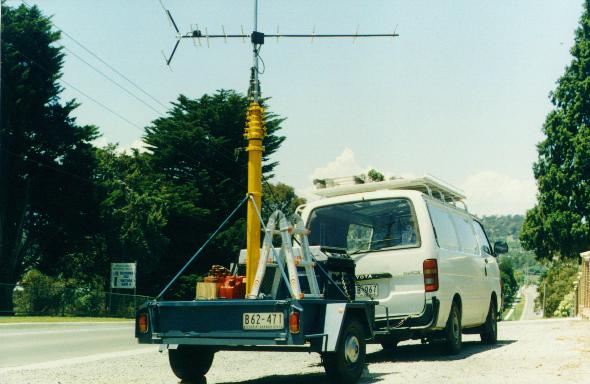
HSV7 IMPULSIVE NOISE TESTS of DVB-T on VHF
OBJECTIVE:
To examine the effect of impulsive noise on reception of VHF DVB-T signals particularly with respect to 2K / 8K COFDM.
METHOD:
A DVB-T signal was transmitted on Channel 12 from the HSV7 site on Mt Dandenong from 09:00 Thursday 25 November until 08:30 Monday 29 November 1999 using an NEC transmitter.
The source was HSV7 program video encoded at 8 Mbps producing a 19.35 Mbps transport stream which was modulated with an NDS encoder set for 64QAM, FEC=2/3, guard interval=1/8, Reed-Soloman=188/204.
A variable attenuator was inserted in the transmitter RF drive to enable output power to be reduced in 1dB steps from a nominal 3.5 kW which corresponded to the license power of 50 kW ERP average at the maximum of HSV7ís horizontal radiation pattern. (ie 4.7dB lower than PAL peak sync ERP).
The linearity corrector of the transmitter was turned off and shoulder Intermod Products were confirmed to be better than 30dB down with up to 40 dB attenuation.
Three DVB-T receivers were set up in the HSV7 digital test van.
A Hills Y10/6-11 aerial was tested and found to have good performance at Channel 12. Using a pump-up mast mounted in a steel trailer, it was elevated from 3.5m AGL to 10m AGL.
Also mounted in the trailer was a 3 cylinder Honda petrol generator which has been found to be a significant source of impulse noise.
The attached test results were obtained by observing the DVB-T pictures and gradually reducing transmitter power until picture errors occurred. A "settling" time had to be allowed after each switch because the attenuator caused a disturbance to the signal and sometimes it would take about half a minute for the digital receiver to optimise to the new setting. Then the number of visible errors were counted for a 1 minute period.
This procedure was repeated at a number of sites, with the Impulse noise source (ie generator) turned off and on for both 2K and 8K carrier systems.
RESULTS:
Impulsive noise, such as that generated by a poorly suppressed Kettering ignition system on an internal combustion engine, severely degraded the C/N margin of the three receivers tested.
The 8K carrier system was typically around 12 dB and up to 16 dB better than the 2K system in the presence of severe impulse noise.
If these receivers are typical of future production receivers then the 8K carrier system is deemed to have a substantial advantage over the 2K system.
FURTHER WORK:
Further work is recommended to investigate the causes of the observed differences and devise methods of reducing the effects of impulsive noise further.
One receiver manufacturer has suggested that the impulsive noise is upsetting AGC and that substantial improvement is possible.
Others have claimed that aerial cabling picks up a substantial part of the interference so good installation practices are essential.
Our tests involved using different cables (which made no apparent difference) and moving them in relation to the impulsive noise source. It was found that replacing the aerial with a 75 ohm termination resulted in virtually no pickup from the cable. But, with the aerial connected, pickup from the cable was substantial. A unity gain head-amplifier providing a good 75 ohm source-termination was found to reduce impulsive noise pickup from the cable significantly. This suggests that balun/matching improvement for aerials warrants further investigation. Perhaps active baluns mounted right at the dipole would provide an ideal solution for difficult installations.
ACKNOWLEDGEMENTS:
Special thanks to:
NEC for providing the transmitter.
RFS for providing the adjacent channel combiner.
NDS for providing receivers.
BT & Advanced Automation for providing a receiver & MPEG2 decoder.
Itis & Quantum for providing a receiver.
Philips for providing an MPEG2 encoder.
Peter Smith, Kelly Kennedy & Joe Beliga for their tireless assistance.
John Hill HSV7 Engineer 1 December 1999
Notes for attached results (Pages 3 to 6)





Fig 1. Typical spectrum display showing HSV7, GTV9, ATV10 and Digital Channel 12 ex HSV7 transmitting facility.
Note noise spectrum from generator overlaid both with digital signal OFF and digital signal ON.

Fig 2. HSV7 test van with trailer, pump-up mast, generator and Hills Y10 aerial showing proximity of aerial to generator as used for site 1 and site 2.
Note that aerial was pumped up to full height of 10 metres for site 3 and site 4.
![]() Return to 1999 Reports
Return to 1999 Reports
![]() Return to Digital TV
Return to Digital TV
![]() Return to Lab Home
Return to Lab Home
Last update: 14/01/2000
Ext Hits: 5448